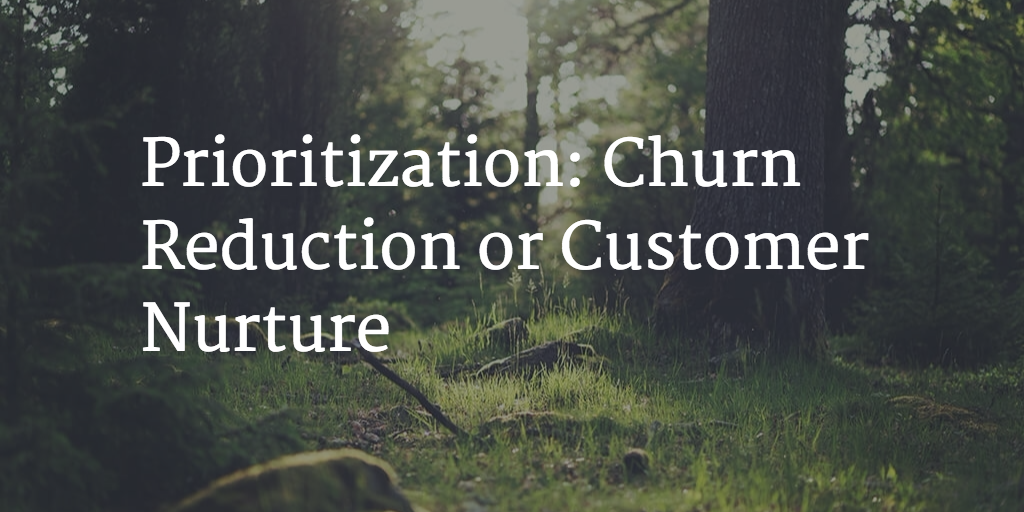Since Customer Success Management isn’t just about reducing churn by retaining customers, but also growing their use of your product over time, I often talk about everything from churn mitigation to Customer Nurture campaigns.
When I talk about all of those things, I’m almost always asked which they should focus on first; retention or nurture.
Here’s my take on that…
How to Save Customers About to Churn
First, if you have a customer that’s about to cancel, their experience with you to-date has been horrible, they’ve received zero value after a significant amount of time, and they just want to cancel, “Customer Success” is not going to help here. It’s too late.
Customer Success is proactive… what you’re looking for is a miracle.
If you think you can help them get back on the path toward success (this is a good time to be intellectually honest with yourself and not to let FOMO – the Fear of Missing Out – keep you from just letting them go), and you think it’s in everyone’s best interest to keep them as a customer, then your best bet is to try to re-sell them on staying – otherwise known as begging – but if it’s a lost cause, it’s a lost cause. Just let ’em go.
In fact, if they’re so far gone they just want out, it’s probably best to just let them go so you don’t hurt their experience with your company any further. You may not be able to save them as a customer at this point, but you may be able to keep them from hating you (even more).
So let ’em go and then DON’T LET THIS HAPPEN AGAIN!
Don’t let customers get to this point. Learn from this experience.
Most of the time, I get the original question because there is a lack of resources in the Customer Success organization forcing them to have to make tough decisions like this. Given enough time and money, anything is possible, so if you aren’t resource-constrained, do these things in parallel.
But for the rest of us, we have to prioritize, so let’s look at the best way to do that.
First, Prioritize Churn Mitigation
First, stop the bleeding. While at-risk customers make up a minority of your overall accounts (at least I hope so), losing customers is a drag on growth and we need to stop that.
So if you have a lot of customers at-risk for churn right now, I’d focus all immediate attention on helping them get back on a path to achieving their Desired Outcome. You’ll probably want to segment customers (by revenue, revenue potential, use case, etc.) so you can apply the correct tactics to help them achieve that Desired Outcome.
The way to think about this is to do what you have to do to get them out of the “at-risk” status (that may be very 1:1), and then move them to a special nurture track specifically for these close-to-at-risk customers (that may involve some 1:1 and some 1:many touches).
They may all be failing to get value in different ways so automating this process isn’t going to work right now for them. Eventually, their success trajectory will take them back to the standard nurture track, but not until that makes sense.
The main take away here is that you shouldn’t be nurturing all customers the same way; ease those who were at-risk into an appropriate nurture track.
Second, Focus on Customer Nurture
Customer Nurture (aka customer marketing or marketing for loyalty) results in better retention (and then expansion, advocacy, etc…. or at least it should), so even if you have percentage of at-risk customers, you’ll eventually want to focus on nurturing your customers.
In a Customer Success-oriented company, how this nurture is done is slightly nuanced from the traditional methods, and ultimately requires well-defined customer segmentation. How you’ll interact with high-touch, high-value, repeat customers vs. a brand new, one-off, lower-revenue (and low revenue-potential) and therefore lower-touch customer will vary.
Generally, whatever the segment “touch” level, you’ll want to leverage automation to scale your human touches. That could mean that the Customer Success organization needs to have access to marketing automation or lifecycle messaging tools themselves, access to a CRM, have designers, copywriters, etc. on staff…. or at least have access to those things.
And if they don’t have those things in the Customer Success org itself, they’ll have to work with the tools and talent in marketing or sales (ops). But this means Customer Success organization’s “customer marketing” efforts need to be prioritized alongside external, acquisition-based activities and campaigns within marketing or sales.
Regardless of the implementation specifics, if your customers aren’t at-risk for churning right now, but you just don’t feel they’re engaged as much as they should be, then I’d focus your energy on building out a nurture strategy.
But if your churn is high, you have to stop the bleeding first.

